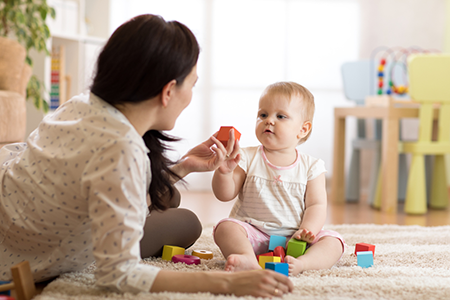 Finding the right person to take care of your baby can be difficult and stressful. Our tips and resources can help.
Finding the right person to take care of your baby can be difficult and stressful. Our tips and resources can help.
Choosing and using a babysitter
Planning time away from your new baby means that you will need to find a trusted babysitter to care for your baby like you would. That may seem impossible. But knowing what qualities you need in a babysitter will help you to find the best person to take care of your child. Womenshealth.gov recommends taking the following steps to help a new babysitter get to know you, your baby, and your home.
Tips for familiarizing a new babysitter with child safety and your home
Safety/first aid:
- Ask if the babysitter knows infant/child CPR and first aid.
- Remind the babysitter that infants should not be placed on an adult bed of any kind.
- Remind the babysitter to place the baby on his/her back to sleep.
- Be sure that the babysitter knows the signs of illness in an infant, including: changes in skin color, sweating, nausea or vomiting, and diarrhea.
- Show the babysitter where the fire extinguishers are kept, and explain how they are used.
- Be sure to show the babysitter where the first aid supplies are kept.
- Remind the babysitter to keep all balloons or plastic items away from the baby.
- Tell the babysitter that children should never be left alone in the bathtub. The sitter should always bring along the children should she or he need to leave the room, such as to answer the telephone or the door bell.
- Remind the babysitter to keep the bathroom door closed and the toilet seat and lid down when not in use.
Familiarity with your house:
- Be sure to give the babysitter a tour of the house.
- Ensure all windows have been closed and that the babysitter knows to keep them closed.
- Show the babysitter how to operate your child safety gates and where they go.
- Show the babysitter where the flashlights are located.
- Make sure you have put away all sharp items, including scissors, knives, and any other objects that can cause injury.
The following online resources have more information on first aid for babysitters:
- American Red Cross Babysitter's Training Course
- The National Safety Council fact sheet on baby-proofing
Choosing and using child care
Many moms go back to work after having a baby and rely on child care for their children. Relatives or family members sometimes take on child-care duties, or children are enrolled in child-care programs. All parents wish the best start for their children. Child care is more than just a service that allows parents to work. It is a world that will affect a child's development in many ways - physically, emotionally, intellectually, and socially. Finding quality child care that is affordable can be challenging. Many parents need inexpensive or cost-free day care where they know their children are safe and are being helped to grow and develop. Parents can contact their local social service agency (listed in the phone book) for information about government-sponsored programs such as Head Start and Early Head Start and other other community programs. Womenshealth.gov recommends taking the following steps to choosing quality child care.
Steps to choosing quality child care
- Look - Visit several child-care homes or centers. Visit the home or center more than once and stay as long as possible so you can get a good feel for what the care will be like for your child. Continue to visit even after you start using the home or center.
- Listen - Make sure the place is cheerful and not too quiet, which can mean not enough activity. Happy-sounding children means they are involved and busy.
- Count - Count the number of children in the group and the number of staff members caring for them. The fewer the number of children for each staff member, the more attention your child will get. Your state will likely have child to provider ratios to follow, so make sure there aren't too many children.
- Ask - Adults who care for children need knowledge and experience. Ask about the background and experience of all staff that will have contact with your child in the home or center.
- Be informed - Find out more about efforts in your community to improve the quality of child care. Ask if the home or center is involved in these activities. Consider getting involved yourself.
More guidelines on choosing child care:
More information on babysitters and child care
Explore other publications and websites
- Child Care 101: Types of Care (Copyright © National Association of Child Care Resource & Referral Agencies): This publication explains the different types of child care and the reasons parents choose each type. The types of child care discussed are child care centers, family child care, in-home caregivers, and care provided by relatives, friends, and family.
Connect with other organizations
